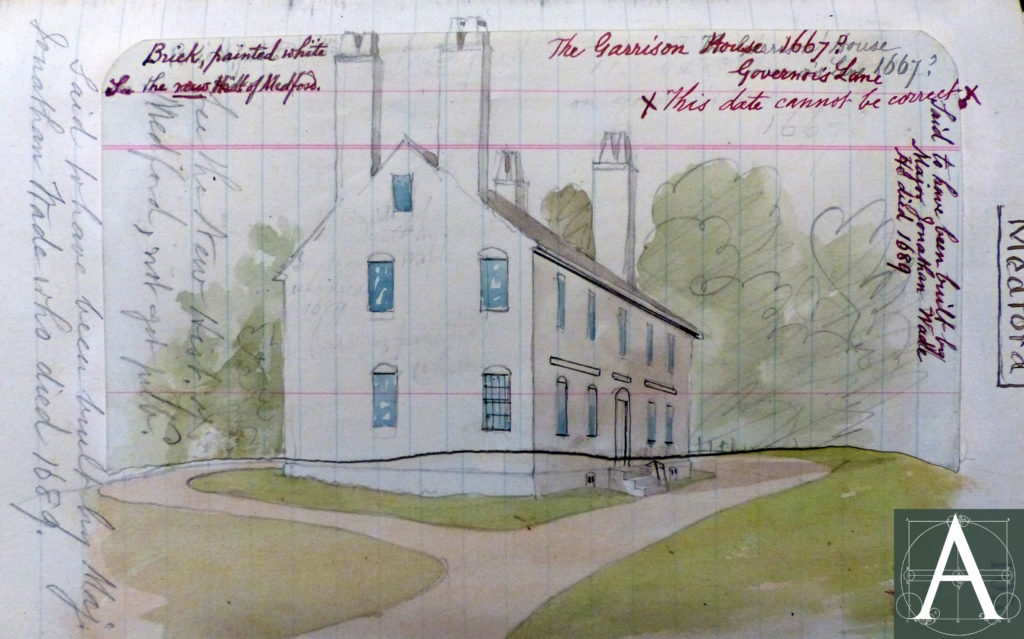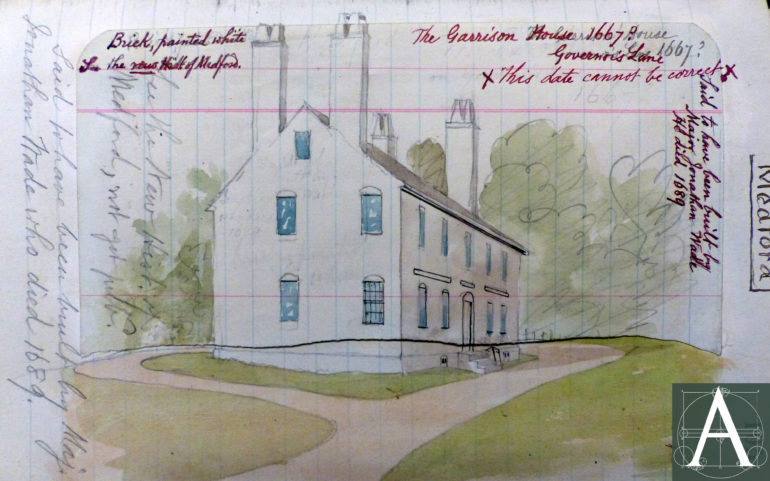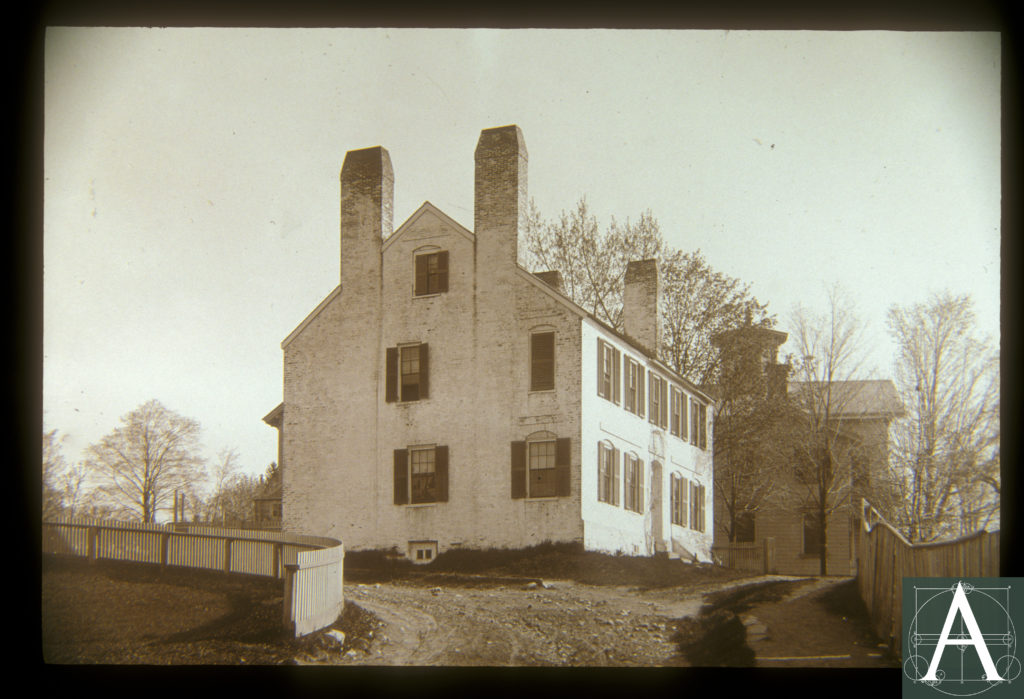One of six known brick houses constructed in Medford during the seventeenth century, of which two others survive (Usher-Royall House and the Peter Tufts House), the Jonathan Wade House was probably built after 1683 when the substantial land holdings of Jonathan Wade, Senior, were divided equally between his two sons, Nathaniel and Jonathan, Jr. In this division, each share of the elder Wade’s estate was valued at £200; buildings were not enumerated and may not have existed on the various parcels of land that were bequeathed to the sons.
When Jonathan Wade, Jr., died six years later in 1689, his estate was valued at £1,602 including his “brick hous, barne, and outhousing at Mistick Bridge [Medford],” which were valued at £350. Since Wade died intestate, his property was divided by the legal formula commonly recognized in New England at the time with ⅓ of the property going to his wife as her right (widow’s thirds), and the balance of the property being divided into equal shares to be distributed to his children, with his son receiving a larger share than Wade’s daughters–1/7 was distributed to each of his five daughters and 2/7 to his son, Dudley.
Preparatory to determining shares of the estate, the court-appointed administrators (of whom Wade’s widow was one) prepared inventories including a room-by-room inventory of the brick house, which they called Wade’s “Mansion house,” enumerating the following rooms:
- parlor chamber
- hall chamber
- hall
- kitchen
- the little bedroom
- the kitchen chamber
- the garrett
Although not enumerated in the inventory, the house also contained a “parlour” and numerous “clossets” mentioned in the subsequent division of the property. Shares in the brick house were granted to heirs, room by room:
- To Elizabeth Wade, “relict widow – The Hall in the Brick House, the Hall Chamber, Two little Rooms at the North corner of sd. house, ½ the East Garrett on ye East side thereof, ⅓ of ye wash house, the stable & the Leantows belonging to it, & the yard adjoining, also ½ of one Bay in the Barn…with the priviledge of the floor to thresh her English Corn on & the East Seller…with a way thro ye middle seller to Her East Seller.”
- To Dudley Wade, only surviving son – “one Large Room in the Brick house, called the Kitchen but may be improved for other Service, one large Closset or Buttery called a Fflanker, the chamber over the Kitchen with the Two Clossetts therein and a priviledge at the Stayers head, the whole West garrett with the Cockloft over it…⅓ of the wash house, ½ of the Great Barn…he is to have the whole of the West Seller with a way through ye middle Seller to it.”
- To Prudence Swann “…part of the Brick house, Viz ͭ: that Room called ye Parlor [valued at] 35£ and half the Middle Seller, ⅙th of the Wash House, ¼th of the East Garrett on ye North side thereof…”
- And “Lastly Elisabeth Wade hath set out her part of the Brick house namely the Parlour Chamber, one half the middle Seller, ¼ of the East Garrett.”
The house remained in divided ownership for nearly fifty years before it was consolidated by Andrew Hall in the 1730s. During that period, the various shares changed hands through sale, such as that from Dudley Wade to Stephen Willis, housewright, in 1709 for £250, and by inheritance, such as the share that descended to Benjamin Willis through his mother, Prudence Wade.
It is possible that Andrew Hall occupied part of the house in the 1720s prior to the construction of his own house nearby at 43 High Street, Medford. Local tradition reports that the house was enlarged and remodeled for Benjamin Hall, Sr. (1731-1817), son of Andrew Hall, at the time of his wedding to Hepzibah Jones in 1752. Given the number of rooms described in the seventeenth-century inventory of the house and its present size, it is unlikely that the house was enlarged, but rather that the façade (east elevation) and eastern halves of the gable ends (north and south elevations) were remodeled with more up-to-date, ambitious Georgian-style details that reflected the family’s prosperity as the town’s leading merchants. Alterations made at this time include the refacing of the façade with brick laid in Flemish bond and the installation of a moulded brick water table, a moulded brick cornice, gauged flat arches with cambered undersides at window heads and projecting belt courses, which remain in position. The house was subsequently occupied by Benjamin Hall, Jr., from 1777 until 1786 when he moved to the new house built for him nearby on High Street.
During the nineteenth century, the house acquired the folkloric name of “Garrison House” and “Old Fort,” based upon fanciful and inaccurate identification of the Peter Tufts House as a house built for Governor Craddock in 1634 during the town’s initial settlement. Local historian and antiquarian Charles Brooks made the assumption that the thick brick walls of the Peter Tufts House and its “porthole windows” were proof of its intended use as a fort. Brooks then seems to have applied the same reasoning to the Wade House, although no early property records that use this name or mention the building’s use for defensive purposes have been identified.
Brick houses of this sort are rarities in New England due to the region’s lack of building lime with which to make mortar. Consequently, early brick houses were considered notable as the best buildings in their communities well into the mid-nineteenth century. In the 1860s-1880s, Edwin Whitefield traveled the region preparing watercolor sketches of historic buildings that were published in Homes of Our Forefathers; his sketches, now in the possession of Historic New England, contain annotations noting brick houses that were the first in their communities.
The mis-identification of the Wade House as a garrison house may have been partly responsible for the house’s purchase in 1893 by Medford’s most prominent citizen and benefactor, General Samuel Crocker Lawrence, who also acquired the Peter Tufts House for its antiquarian value. Under Lawrence’s ownership, the house was subject to a renovation in which numerous Colonial Revival-style elements were added, including the projecting entry hood and masonry stoop at the east entry and the three pedimented dormers on the east slope of the roof.

Pre-1886 watercolor view of the Wade House by Edwin Whitefield showing exterior coating of white [image courtesy of Historic New England]
READ MORE about the Jonathan Wade House


